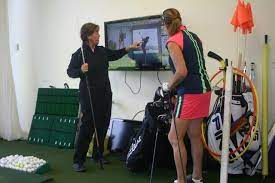Golf is a sport that requires a combination of physical skill, mental focus, and strategic thinking. To excel in golf, players need to develop a range of skills, from driving and iron play to chipping and putting. In recent years, technology has played an increasingly important role in golf coaching and training, offering new tools and techniques for players to improve their skills and performance on the course. In this article, we’ll take a closer look at the role of technology in golf coaching and training.
Swing Analysis
One of the most important ways that technology is used in golf coaching and training is through swing analysis. Swing analysis software and hardware can provide detailed data on a player’s swing, including clubhead speed, swing path, and ball flight. This data can be used to identify areas for improvement in a player’s swing and to develop personalized training plans to address these areas.
Launch Monitors
Launch monitors are another important tool used in golf coaching and training. These devices use radar or camera technology to measure various aspects of a player’s shot, including ball speed, launch angle, and spin rate. This data can be used to optimize a player’s equipment, such as club selection and ball choice, and to improve their overall shot performance.
Putting Aids
Putting is a critical component of the game, and technology has played an increasingly important role in putting instruction and training. Putting aids, such as putting mats and alignment aids, can help players develop a more consistent and accurate putting stroke. In addition, putting analysis software can provide detailed data on a player’s putting stroke, including stroke path and impact position, which can be used to identify areas for improvement.
Simulator Technology
Simulator technology has become increasingly popular in golf coaching and training. These devices use advanced graphics and motion capture technology to create a virtual golf course that players can use to practice their shots and improve their skills. Simulator technology can provide a safe and controlled environment for players to practice their shots, and it can also help players develop a deeper understanding of the strategic and tactical aspects of the game.

Mobile Apps
Mobile apps are another important tool used in golf coaching and training. These apps can provide a range of features, such as swing analysis, GPS distance tracking, and scorekeeping. Many apps also offer personalized training plans and instructional videos to help players improve their skills and performance on the course.
Wearable Technology
Wearable technology, such as smartwatches and fitness trackers, are increasingly being used in golf coaching and training. These devices can provide real-time data on a player’s performance, including heart rate, step count, and calories burned. In addition, some wearable technology can provide data on a player’s swing, such as swing speed and tempo, which can be used to improve their overall performance on the course.
Online Coaching
Finally, technology has also enabled online coaching, which allows players to receive personalized coaching and training from anywhere in the world. Online coaching can be delivered through video conferencing, email, or online training platforms, and it can provide a convenient and flexible way for players to improve their skills and performance on the course.
Technology has played an increasingly important role in golf coaching and training, offering new tools and techniques for players to improve their skills and performance on the course. From swing analysis and launch monitors to putting aids and simulator technology, technology has enabled players to achieve new levels of performance and success in the sport. By embracing these new technologies and techniques, players can become more confident and consistent on the course, and they can enjoy a more rewarding and enjoyable golf experience. So, start exploring the world of technology in golf coaching and training today, and get ready to take your game to the next level!
It’s worth noting that technology has not only transformed the way that players train and improve their skills, but it has also changed the way that coaches and instructors deliver instruction. Through online coaching and video analysis, coaches can now provide personalized instruction to players anywhere in the world, enabling them to reach a wider audience and improve the skills of players at all levels of the game.

In addition, technology has also helped to democratize golf, making it more accessible and affordable for players of all backgrounds and skill levels. Through mobile apps, simulator technology, and online coaching, players can now access the same training and instruction that was once only available to elite players and professionals.
Finally, it’s worth noting that technology has also helped to make golf a more data-driven and analytical sport. By providing detailed data on a player’s performance and technique, technology has enabled players and coaches to identify areas for improvement and to develop personalized training plans to address these areas. This data-driven approach to golf coaching and training has helped players to achieve new levels of performance and success on the course.
Conclusion
It’s also important to note that while technology can be a valuable tool for golf coaching and training, it is not a replacement for hard work, dedication, and practice. Ultimately, it is up to the player to put in the time and effort to improve their skills and performance on the course. Technology can provide valuable data and feedback, but it is up to the player to apply this information and to develop a deeper understanding of the game.
In addition, it’s worth noting that technology should be used in conjunction with traditional coaching and instruction. While technology can provide valuable data and feedback, it is important for players to receive personalized instruction and feedback from a qualified coach or instructor. A coach can provide the guidance and support needed to help players develop their skills and to overcome challenges and obstacles on the course.
Finally, it’s worth noting that technology is constantly evolving and changing, and it is important for players and coaches to stay up to date with the latest tools and techniques. As new technologies emerge, players and coaches must be willing to adapt and incorporate these new tools into their training and coaching programs.



